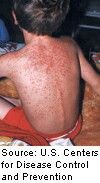Timing Is Crucial in Measles Vaccination
The age at which the protective effect of maternal measles antibodies wears off varies widely from region to region and should be taken into account when formulating optimum immunization strategies, according to an editorial published online July 24 in BMJ.

FRIDAY, July 25 (HealthDay News) -- The age at which the protective effect of maternal measles antibodies wears off varies widely from region to region and should be taken into account when formulating optimum immunization strategies, according to an editorial published online July 24 in BMJ.
Helene Broutin, Ph.D. and Mark A. Miller, M.D., of the National Institutes of Health in Bethesda, Md., write that routine vaccination against measles has brought the disease under control in high-income countries and most countries of the Americas, but that measles risk remains unacceptably high in Africa and South Asia.
The duration of protection from placental transfer of measles antibodies depends on several factors, including the vaccination and HIV status of the mother and child, as vaccinated mothers transfer fewer measles antibodies than naturally immune mothers, HIV-positive mothers transfer lower titer antibodies than HIV-negative mothers, and HIV-positive infants lose protection by these antibodies more rapidly. Timely administration of vaccines should be considered alongside wider coverage by vaccination campaigns, the authors write.
"In developing countries, earlier vaccination strategies could be considered but may mean that a higher proportion of children fail to respond initially," the authors write. "To minimize this trade-off, research should focus on new estimations of the duration of maternal antibodies in children, with consideration for the vaccination and HIV statuses of the mothers."
Copyright © 2008 ScoutNews, LLC. All rights reserved.